Portable Machine with Embedded System for Applying Granulated Fertilizers at Variable Rate
Abstract
1. Introduction
2. Materials and Methods
2.1. Development of the Metering Mechanism and Its Electronic Control Unit
2.2. Laboratory Tests
2.3. Field Tests
3. Results and Discussion
3.1. Evaluation of the Metering Mechanism in the Laboratory
3.2. Evaluation of Machine Performance in the Field
4. Conclusions
5. Patents
Author Contributions
Funding
Institutional Review Board Statement
Data Availability Statement
Acknowledgments
Conflicts of Interest
References
- Vitória, E.L.d.; Krohling, C.A.; Borges, F.R.P.; Ribeiro, L.F.O.; Ribeiro, M.E.A.; Chen, P.; Lan, Y.; Wang, S.; Moraes, H.M.F.e.; Furtado Júnior, M.R. Efficiency of fungicide application an using an unmanned aerial vehicle and pneumatic sprayer for control of Hemileia vastatrix and Cercospora coffeicola in mountain coffee crops. Agronomy 2023, 13, 340. [Google Scholar] [CrossRef]
- Dou, H.; Wang, C.; Zhang, J.; Cheng, G.; Wang, Z. Transforming mountain agriculture in China: Linking smallholder family production and moderate-scale agriculture. Sustain. Futures 2024, 7, e100208. [Google Scholar] [CrossRef]
- Wang, B.; Zhu, J.; Chai, X.; Liu, B.; Zhang, G.; Yao, W. Research status and development trend of key technology of agricultural machinery chassis in hilly and mountainous áreas. Comput. Electron. Agric. 2024, 226, e10445. [Google Scholar] [CrossRef]
- Santana, L.S.; Ferraz, G.A.e.S.; Cunha, J.P.B.; Santana, M.S.; Faria, R.d.O.; Marin, D.B.; Rossi, G.; Conti, L.; Vieri, M.; Sarri, D. Monitoring errors of semi-mechanized coffee planting by remotely piloted aircraft. Agronomy 2021, 11, 1224. [Google Scholar] [CrossRef]
- Penuels, J.; Coello, F.; Sardans, J. A better use of fertilizers is needed for global food security and environmental sustainability. Agric. Food Secur. 2023, 12, 5. [Google Scholar] [CrossRef]
- Kouadio, L.; Deo, C.R.; Byrareddy, V.; Adamowski, J.F.; Shahbaz Mushtaq, S.; Nguyend, V.P. Artificial intelligence approach for the prediction of Robusta coffee yield using soil fertility properties. Comput. Electron. Agric. 2018, 155, 324–338. [Google Scholar] [CrossRef]
- Wang, Y.; Yuan, Y.; Yuan, F.; Ata-UI-Karim, S.T.; Liu, X.; Tian, Y.; Zhu, Y.; Cao, W.; Cao, Q. Evaluation of Variable Application Rate of Fertilizers Based on Site-Specific Management Zones for Winter Wheat in Small-Scale Farming. Agronomy 2023, 13, 2812. [Google Scholar] [CrossRef]
- Chen, C.; He, P.; Zhang, J.; Li, X.; Ren, Z.; Zhao, J.; He, J.; Wang, Y.; Liu, H.; Kang, J. A fixed-amount and variable-rate fertilizer applicator based on pulse width modulation. Comput. Electron. Agric. 2018, 148, 330–336. [Google Scholar] [CrossRef]
- Fulton, J.P.; Shearer, S.A.; Higgins, S.F.; Hancock, D.W.; Stombaugh, T.S. Distribution pattern variability of granular VRT applicators. Trans. ASABE 2005, 48, 2053–2064. [Google Scholar] [CrossRef]
- Hu, G.; Chen, J.; Jian, B.; Wan, H.; Liu, L. Modeling and simulation of transportation system of screw conveyors by the discrete element method. In Proceedings of the 2010 International Conference on Mechanic Automation and Control Engineering, Wuhan, China, 26–28 June 2010; pp. 927–930. [Google Scholar] [CrossRef]
- Galvão, C.B.; Albiero, D.; Garcia, A.P.; Monteiro, L.A. Fertilizer metering mechanism with helical conic cylindrical thread for family agriculture. Eng. Agric. 2018, 38, 934–940. [Google Scholar] [CrossRef]
- Spagnolo, R.T.; Rosa, D.P.; Pinho, M.S.; Schiavon, C.S.; Schmechel, D.H. Performance of helical metering mechanisms in the application of microgranular fertilizer. Eng. Agric. 2020, 4430, 481–488. [Google Scholar] [CrossRef]
- Zimmermann, G.G.; Jasper, S.P.; Kmiecik, L.L.; Strapasson, N.L.; Silva, T.X.; Oiole, Y.A. Development of test bench to determine the distribution of granular fertilizers in planting rows using spiral roller, two spiral rollers and fluted roller. PLoS ONE 2020, 15, e0243799. [Google Scholar] [CrossRef] [PubMed]
- Spagnolo, R.T.; Rosa, D.P.; Pinho, M.S.; Schiavon, C.S.; Schmechel, D. Models for predicting the performance of fertilizer metering in seed cum fertilizer drill. Braz. J. Agric. Environ. Eng. 2021, 25, 51–57. [Google Scholar] [CrossRef]
- Sugirbay, A.M.; Zhao, J.; Nukeshev, S.O.; Chen, J. Determination of pin-roller parameters and evaluation of the uniformity of granular fertilizer application metering devices in precision farming. Comput. Electron. Agric. 2020, 179, 330–336. [Google Scholar] [CrossRef]
- Alcarde, J.C.; Malavolta, E.; Borges, A.L.; Muniz, A.S.; Veloso, C.A.; Fabrício, A.C.; Viegas, L.J.M. Higroscopicity evaluation of fertilizers and agricultural liming materials. Sci. Agrícola 1992, 49, 137–144. [Google Scholar] [CrossRef]
- Ministry of Agriculture, Livestock and Food Supply of Brazil. Normative Instruction Nº. 61, of July 8, 2020. Available online: https://www.gov.br/agricultura/pt-br/assuntos/insumos-agropecuarios/insumos-agricolas/fertilizantes/legislacao/in-61-de-8-7-2020-organicos-e-biofertilizantes-dou-15-7-20.pdf (accessed on 3 February 2025).
- Ribeiro, A.C.; Guimarães, P.T.G.; Alvarez, V.V.H. Soil fertility commission of the State of Minas Gerais. In Recommendations for the Use of Correctives and Fertilizers in Minas Gerais—5th. Approximation, 5th ed.; Minas Gerais State Soil Fertility Commission: Viçosa, Brasil, 1999; pp. 25–32. [Google Scholar]
- Qgis Development Team. QGIS Geographic Information System. 2009. Available online: http://qgis.org (accessed on 3 February 2025).
- Angnes, G.; Martello, M.; Faulin, G.D.C.; Molin, J.P.; Romanelli, T.L. Energy Efficiency of Variable Rate Fertilizer Application in Coffee Production in Brazil. AgriEngineering 2021, 3, 815–826. [Google Scholar] [CrossRef]
- Jovarauskas, D.; Steponavičius, D.; Kemzūraitė, A.; Zinkevičius, R.; Venslauskas, K. Comparative analysis of the environmental impact of conventional and precision spring wheat fertilization under various meteorological conditions. J. Environ. Manag. 2021, 296, e113150. [Google Scholar] [CrossRef]
- Kazlauskas, M.; Bručienė, I.; Jasinskas, A.; Šarauskis, E. Comparative Analysis of Energy and GHG Emissions Using Fixed and Variable Fertilization Rates. Agronomy 2021, 11, 138. [Google Scholar] [CrossRef]
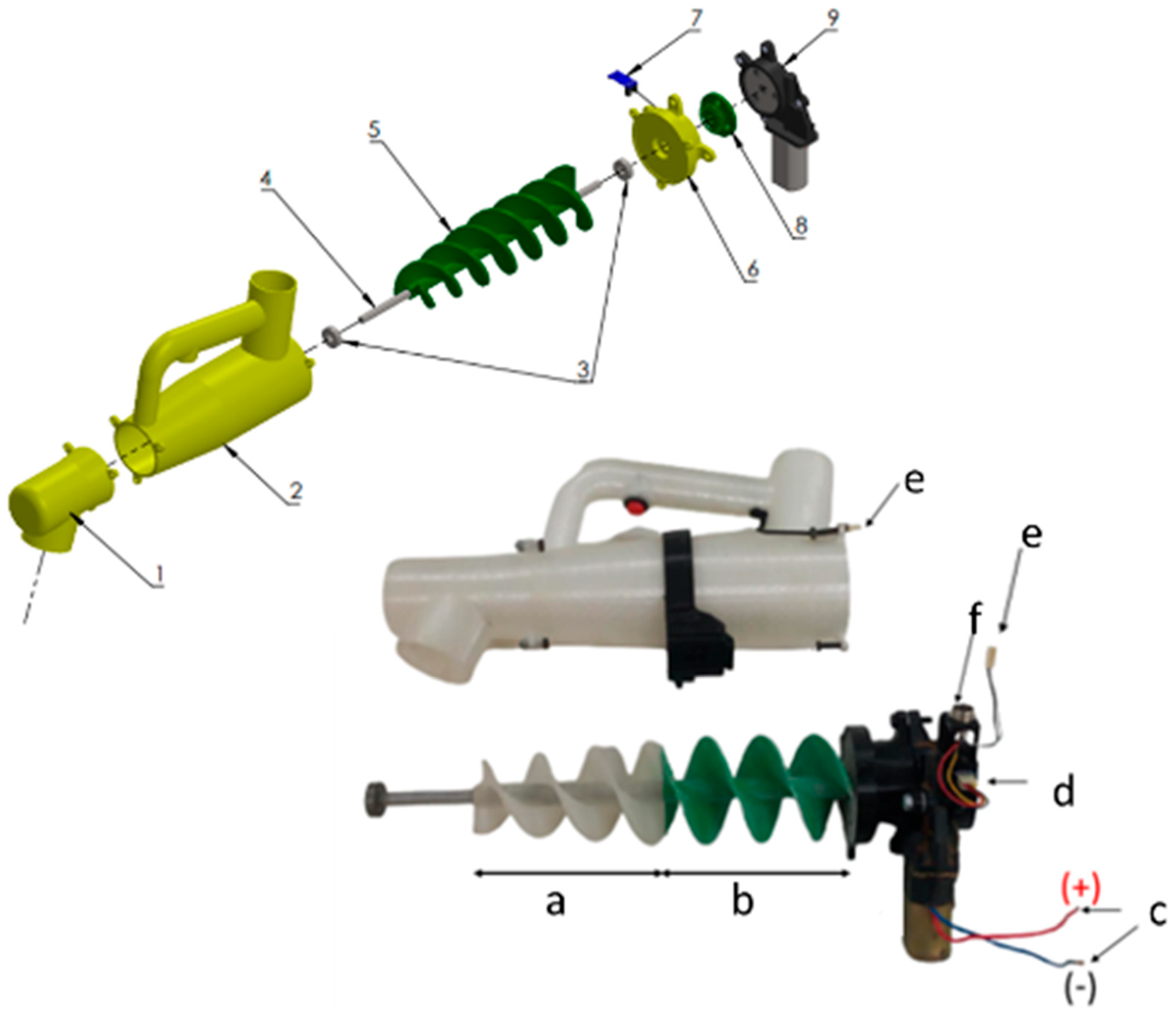
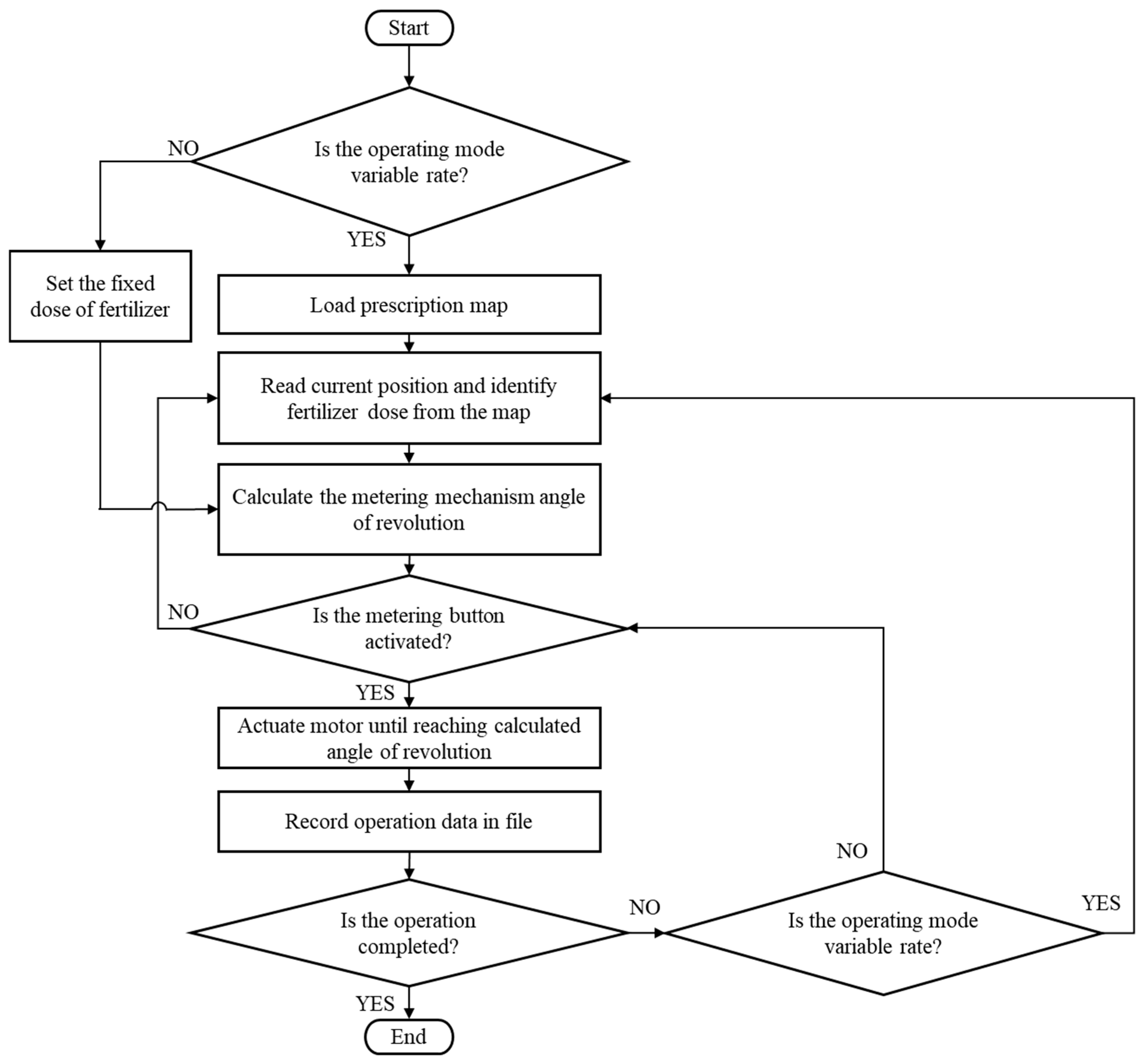
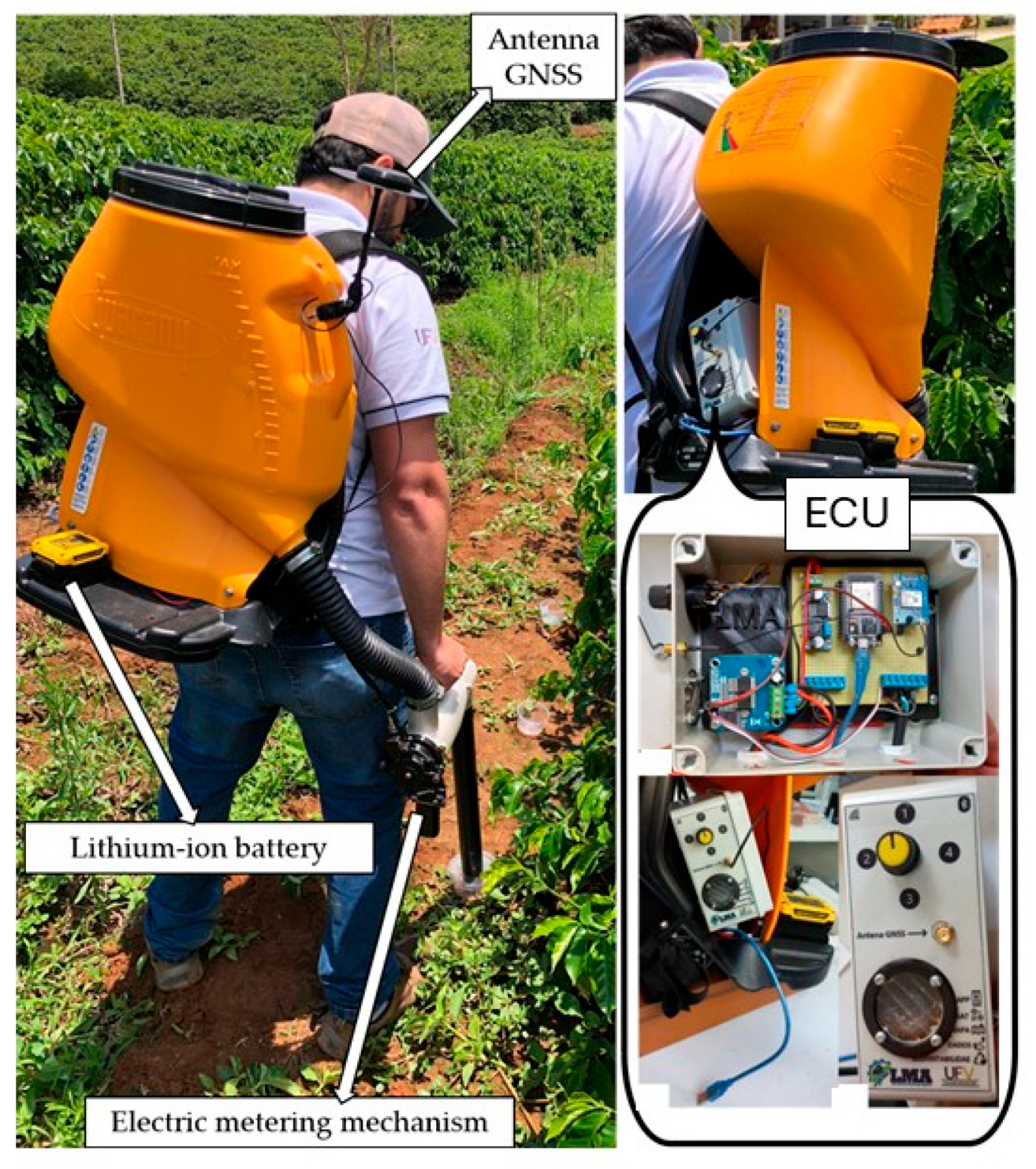
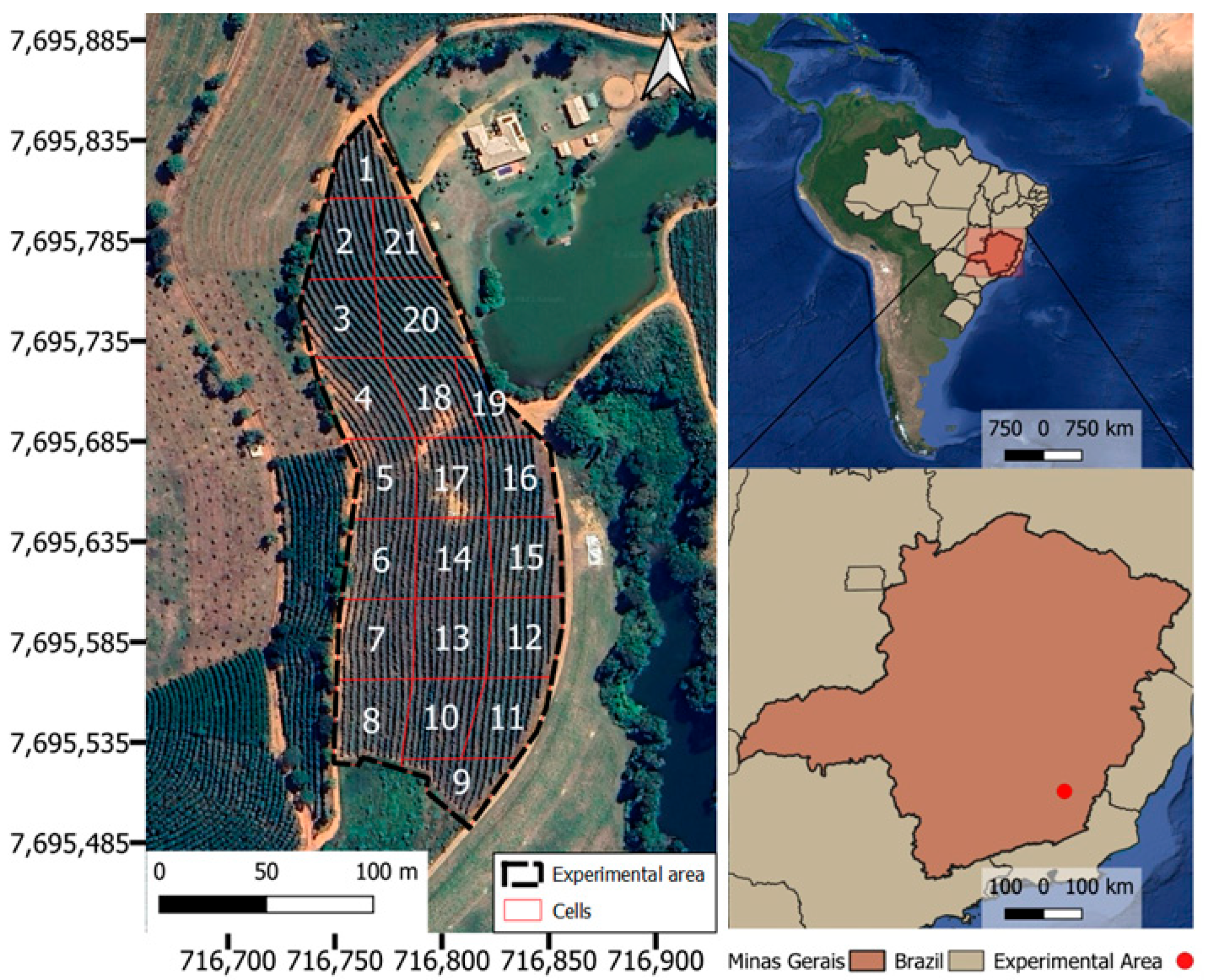
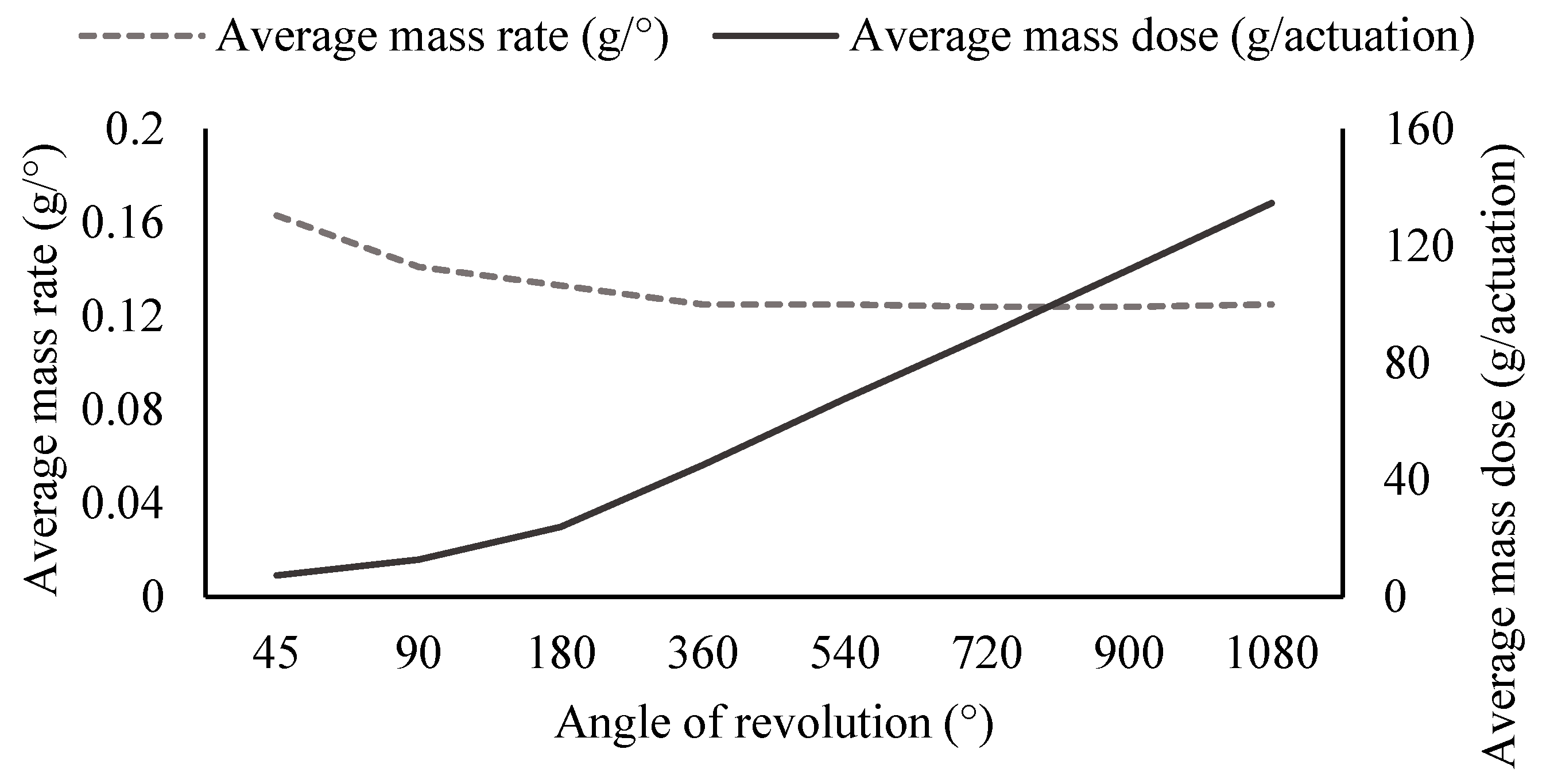
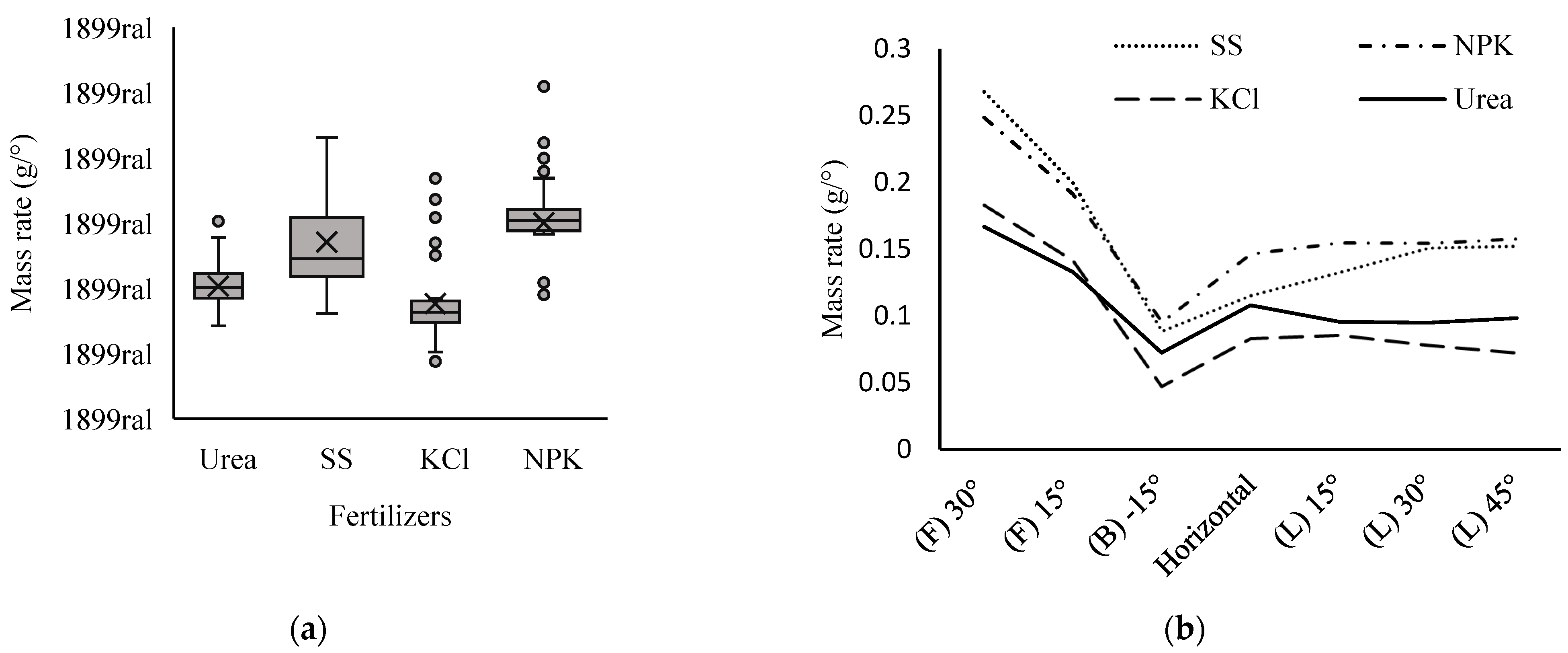
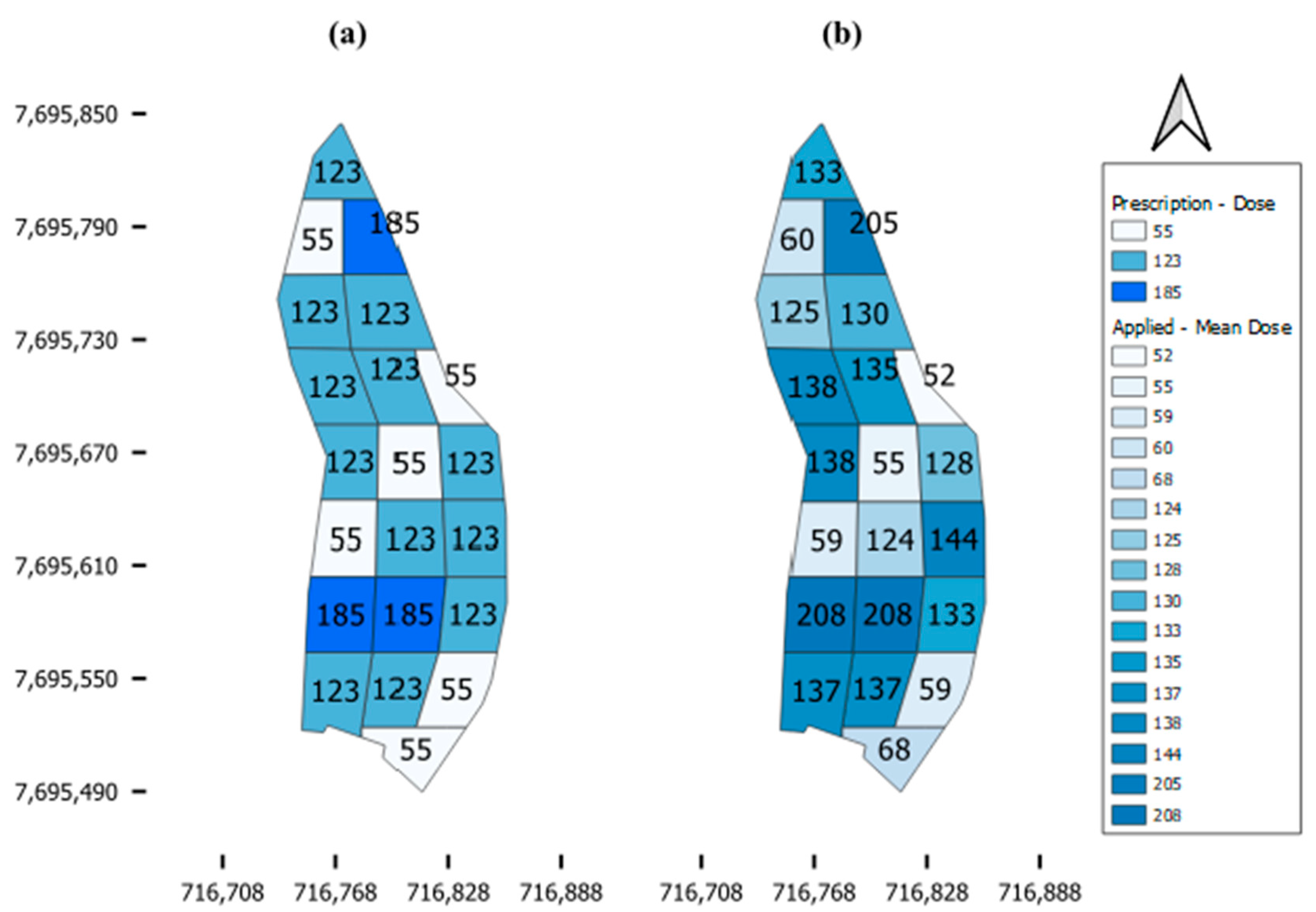



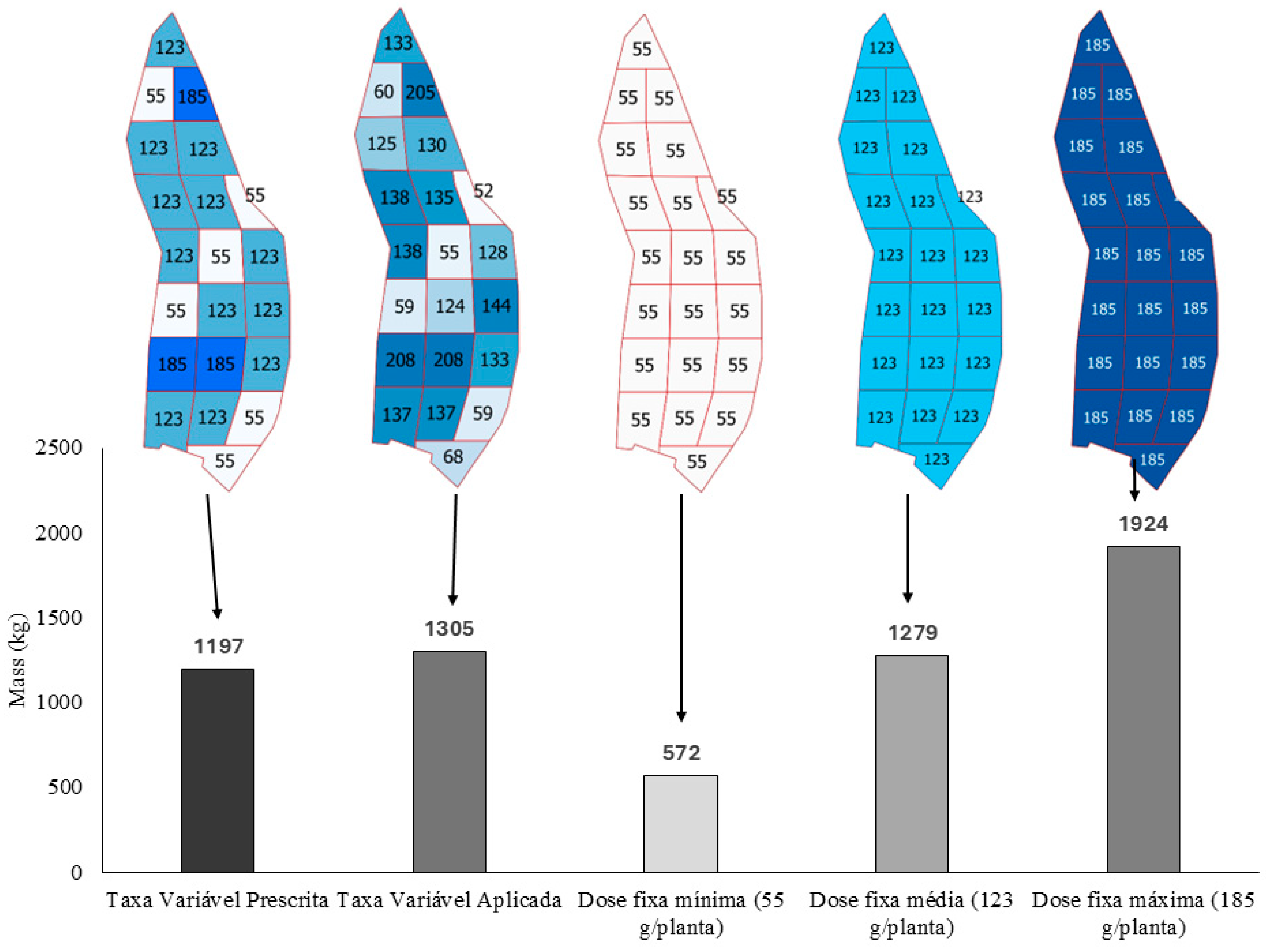
| Fertilizer | Particle-Size Classification | Angle of Repose (°) | Water Content (%) | Specific Mass (g/mL) |
|---|---|---|---|---|
| KCl | Granulated | 40.70 | 0.4237 | 1.044 |
| SS | Powdered | 46.06 | 2.3984 | 1.210 |
| NPK | Powdered | 39.27 | 2.0589 | 1.109 |
| Urea | Granulated | 38.86 | 0.6978 | 0.745 |
| Cell | Area (ha) | Number of Plants | Prescribed Quantity (kg) | Applied Quantity (kg) | Average Time (hours) | Effective Operational Capacity (ha/h) |
|---|---|---|---|---|---|---|
| 1 | 0.093 | 372 | 45.756 | 49.433 | 1.002 | 0.082 |
| 2 | 0.107 | 428 | 23.540 | 25.833 | 0.856 | 0.113 |
| 3 | 0.135 | 540 | 66.420 | 67.361 | 1.350 | 0.090 |
| 4 | 0.140 | 560 | 68.880 | 77.128 | 0.996 | 0.129 |
| 5 | 0.118 | 472 | 58.056 | 65.144 | 1.049 | 0.100 |
| 6 | 0.130 | 520 | 28.600 | 30.879 | 0.924 | 0.129 |
| 7 | 0.142 | 568 | 105.080 | 117.986 | 1.357 | 0.090 |
| 8 | 0.141 | 564 | 69.372 | 76.991 | 1.316 | 0.100 |
| 9 | 0.098 | 392 | 21.560 | 26.836 | 0.697 | 0.129 |
| 10 | 0.124 | 496 | 61.008 | 68.126 | 1.901 | 0.090 |
| 11 | 0.124 | 496 | 27.280 | 29.067 | 4.795 | 0.113 |
| 12 | 0.130 | 520 | 63.960 | 68.885 | 3.178 | 0.129 |
| 13 | 0.141 | 564 | 104.340 | 117.132 | 2.287 | 0.100 |
| 14 | 0.140 | 560 | 68.880 | 69.469 | 0.871 | 0.150 |
| 15 | 0.131 | 524 | 64.452 | 75.456 | 1.077 | 0.113 |
| 16 | 0.126 | 504 | 61.992 | 64.304 | 1.008 | 0.113 |
| 17 | 0.129 | 516 | 28.380 | 28.182 | 0.946 | 0.129 |
| 18 | 0.125 | 500 | 61.500 | 67.375 | 1.000 | 0.113 |
| 19 | 0.067 | 268 | 14.740 | 13.820 | 0.313 | 0.180 |
| 20 | 0.155 | 620 | 76.260 | 80.463 | 2.377 | 0.113 |
| 21 | 0.104 | 416 | 76.960 | 85.064 | 1.340 | 0.069 |
Disclaimer/Publisher’s Note: The statements, opinions and data contained in all publications are solely those of the individual author(s) and contributor(s) and not of MDPI and/or the editor(s). MDPI and/or the editor(s) disclaim responsibility for any injury to people or property resulting from any ideas, methods, instructions or products referred to in the content. |
© 2025 by the authors. Licensee MDPI, Basel, Switzerland. This article is an open access article distributed under the terms and conditions of the Creative Commons Attribution (CC BY) license (https://creativecommons.org/licenses/by/4.0/).
Share and Cite
Quintão, I.R.; Valente, D.S.M.; Coelho, A.L.d.F.; Queiroz, D.M.d.; Ribeiro Furtado Junior, M.; Villar, F.M.d.M.; Rodrigues, P.H.d.M. Portable Machine with Embedded System for Applying Granulated Fertilizers at Variable Rate. Agriculture 2025, 15, 361. https://doi.org/10.3390/agriculture15040361
Quintão IR, Valente DSM, Coelho ALdF, Queiroz DMd, Ribeiro Furtado Junior M, Villar FMdM, Rodrigues PHdM. Portable Machine with Embedded System for Applying Granulated Fertilizers at Variable Rate. Agriculture. 2025; 15(4):361. https://doi.org/10.3390/agriculture15040361
Chicago/Turabian StyleQuintão, Igor Rodrigues, Domingos Sárvio Magalhães Valente, André Luiz de Freitas Coelho, Daniel Marçal de Queiroz, Marconi Ribeiro Furtado Junior, Flora Maria de Melo Villar, and Pedro Henrique de Moura Rodrigues. 2025. "Portable Machine with Embedded System for Applying Granulated Fertilizers at Variable Rate" Agriculture 15, no. 4: 361. https://doi.org/10.3390/agriculture15040361
APA StyleQuintão, I. R., Valente, D. S. M., Coelho, A. L. d. F., Queiroz, D. M. d., Ribeiro Furtado Junior, M., Villar, F. M. d. M., & Rodrigues, P. H. d. M. (2025). Portable Machine with Embedded System for Applying Granulated Fertilizers at Variable Rate. Agriculture, 15(4), 361. https://doi.org/10.3390/agriculture15040361







